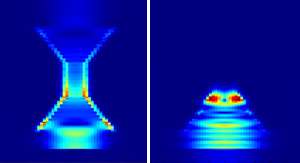Narrow channel that acts as polarization filter adds new dimension to optical data transmission

Private households are increasingly connecting to the Internet via optical fiber networks, whose bandwidth is suitable for delivering on-demand video. The fibers of the network transmit light simultaneously over many channels by using different optical wavelengths. These networks could be expanded by also utilizing light's polarization, which is the plane in which light waves oscillate. A research team at the A*STAR Institute of Microelectronics in Singapore has now developed an optical signal-processing device that is able to filter light with different polarization and fits on a silicon chip.
An optical fiber requires hardware at its end to filter and process the information carried by the light that it is transmitting. Light sent at different wavelengths can be separated with a common spectrometer such as a grating; however, light sent at different polarizations typically can only be separated with crystals that favor one polarization over the other.
Since the required materials do not fit easily onto a computer chip, implementing such schemes has remained difficult, notes Ying Huang from the research team. "Polarization-sensitive performance remains one of the major technology bottlenecks limiting silicon photonics technology today," Huang says. "Existing devices are incompatible with polarization-insensitive optical fiber networks, which are the most dominant application for silicon photonics technology."
The scheme developed by Huang and co-workers is easy to implement. Rather than relying on specific material properties, their generic device uses basic geometric principles—a constriction channel—to control light of different polarizations. The channel is made from silicon and its side walls are insulated with silicon dioxide (see image). Light with a vertically aligned polarization travels along the sides of the device, whereas light with a horizontally aligned polarization travels predominantly along the top surface. The constriction blocks the horizontally polarized light because its width is too narrow to confine the light to the top surface.
In test devices operating at wavelengths typical for optical fiber data transmission and constrictions only 71 nanometers wide, Huang and team demonstrated that 30 times more vertically polarized light passed through each device than its horizontally polarized counterpart. Moreover, the devices operated over a broad range of wavelengths, which will allow microelectronic engineers to combine polarization selection with transmission schemes using different wavelengths.
Huang and team are now working to improve the design and make it easy to implement for on-chip photonics. "The ultimate goal is to provide an attractive 'grab-and-use' type of solution for the silicon photonics community to address the polarization-sensitive performance bottleneck," says Huang.
More information: Huang, Y., Zhu, S., Zhang, H., Liow, T.-Y. & Lo, G. Ultra-compact CMOS compatible TE-pass polarizer for silicon photonics. Optical Fiber Communication Conference/National Fiber Optic Engineers Conference 2013, March 17–21 2013. dx.doi.org/10.1364/NFOEC.2013.JTh2A.27




















